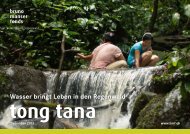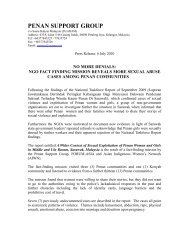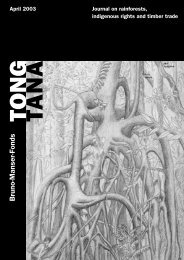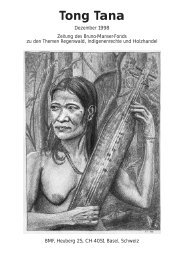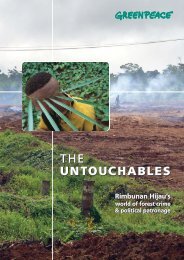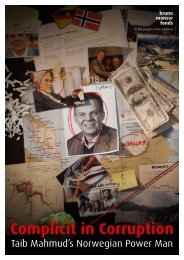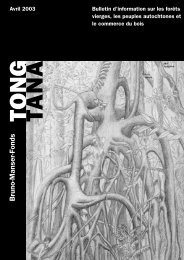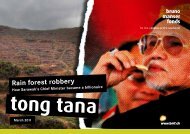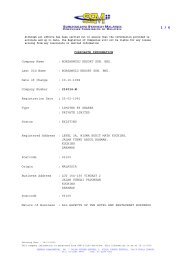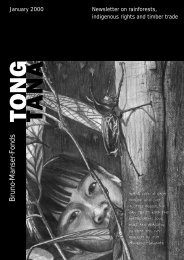PDF - Bruno Manser Fonds
PDF - Bruno Manser Fonds
PDF - Bruno Manser Fonds
- No tags were found...
You also want an ePaper? Increase the reach of your titles
YUMPU automatically turns print PDFs into web optimized ePapers that Google loves.
September 2002Journal on rainforests,indigenous rights and timber trade<strong>Bruno</strong>-<strong>Manser</strong>-<strong>Fonds</strong>
Editorial2 Tong Tana September 2002jk – Half of the original forest area has disappearedfrom the Earth over the last two centuries, most ofwhich in the 50 years after the Second World War. TheUnited Nations’ Food and Agriculture Organization(FAO) estimates the annual loss at 170,000 km 2 , theWorld Resources Institute at more than 200,000 km 2 .On the surface, the reasons for this extensive loss offorest appear to lie in deforestation for agriculturalprojects or for meeting the demand of the local populationfor fuel wood (in the dry, subtropical zones suchas India or South Africa). On closer inspection, however,it becomes clear that these clearing operationsare usually preceded by commercial felling. In the tropics,so-called “selective” felling is practised. As valuabletree species grow only sparsely, large surface areashave to be opened up for individual trunks.Because of the heavy machinery, rough ground anddensely interwoven forest canopy (creepers), up to70% of the forest is destroyed by the extraction of justa few trunks!Commercial logging – which, according to economicexperts is what gives the forest value in the first placeand is therefore supposed to protect it from destruction– undeniably undermines the forest and opens itup to lawless small farmers and poachers. Once thecommercially usable species of trees have disappearedfrom the forest, no-one has the time or sufficientinterest to wait for anything from decades to centuriesfor the natural regeneration. Huge agriculturalprojects (oil palms, pulp wood plantations) are rapidlyreplacing the once natural forest. Fire is used to rid thevast surface areas of the last remaining natural forestand, this year too, extensive parts of South-East Asiaare being smothered beneath an unhealthy cloud ofsmoke again – so much for the argument “protectingthrough use”!In terms of opening doors, commercial tree felling isthe greatest threat to the remaining primeval forests.The wood-processing industry in the countries that exportwood from tropical forests also plays an importantpart in this respect. In some former export countriesthe raw material for the processing industry,which has been massively developed also with Swissmoney, now has to be imported. In others the demandfor raw material is met by illegal logging. With theincreasing scarcity, illegal logging has become anincreasingly pressing problem. According to WorldBank estimates, around 55% of world-wide tree fellingis illegal, i.e. incompatible with the applicable nationallegislations. In several forests, the proportion of illegalwood is even higher, such as, for example, in Cambodia(90%), Brazil (85%), Bolivia (80%) or the Cameroon(50%).Even the timber industry and the export countrieshave, meanwhile, acknowledged the problem – a factthat induced the International Tropical Timber Organisation(ITTO), in the early nineties, to set itself the goalCeremonial sticks protect the Penan from ghosts …and from the greed of the first world, too?of tolerating only sustainably-produced tropical timberon the international market as from the year 2000. TheITTO admits that this goal is still far from beingachieved.Forest and particularly primeval forests have a varietyof different functions. They influence the climate locallyand globally. Primeval forests store many timesmore CO 2 than secondary and planted forests do. Theyprovide a habitat for a large part of the great global varietyof the species. They are both the habitat and foodsource of many indigenous peoples, who today allstand on the brink of disaster. World-wide, several hundredmillions of people are directly dependent on tropicalforests, e.g. the Penan in Malaysia, the Yanomamiin Brazil or the Pygmies in Central Africa. Their povertyis not, as is often claimed, the cause of the deforestingof the tropical forests. On the contrary, theirpoverty is a direct consequence of the destruction oftheir natural environment.The responsibility of wood-importing countries such asSwitzerland therefore lies in putting a stop to the consumptionof wood from overfelling and, instead, usingwood that has been produced in an ecologically and sociallyacceptable way. They must take steps to combatthe global destruction of the forests. National legislationson forests must be improved and effectivelyimplemented. And profit-orientated investors mustfinally assume responsibility. In this respect, onceagain, the governments of the industrial countries arealso challenged because of short-sighted and egotistically-issuedexport risk guarantees! Finally, greater cooperationwith the forest peoples is necessary. Theyare largely excluded from both the proceeds of this timbertrade and international development co-operationefforts. It is therefore also in the interests of the industrialcountries to see an end to the destruction ofthe forests and variety of the species, because thenumbers of victims of landslides, floods, fire-relateddisasters, droughts and famine are continually rising.Increasingly close to our front doors!
Sarawak-Malaysia3 Tong Tana September 2002Traditional opening of themeeting at Long SayanThe Declaration of Long Sayanjk – The biggest Penan meeting since the 1980s washeld from 7 th to 9 th June. More than 700 Penan from47 communities and many nomadic groups cametogether in Long Sayan. This historical meeting wasorganised by the Sarawak Penan Association with thehelp of Sahabat Alam Malaysia SAM and also supportedby the BMF with 2,000 US$. The meeting’saims were to analyse the current situation of thePenan, exchange experiences and strengthen solidarityan traditions.After ceremonial dances, a game of soccer and presentationsof traditional handicraft a discussion washeld on the miserable living conditions of the Penan,their origin and possible solutions. The Penan gave theworst grades to governmental aid which they evaluatedas unsatisfactory to inexistent. Their personal situationsare worsening daily.In the common “Declaration of Long Sayan 2002” thePenan complain that the government does not keep itspromises. They ask why the government constantly declaressuch aid as efficient procedures against povertywhile they, the Penan, become poorer and poorer? Thegovernment must come to realize that the totally obscureissuing of logging licences is the root of the problem.The system gives preference to the interests ofthe political-economic complex who has becomeextremely rich thanks to the looting of the forests.In the Declaration the Penan demand once again therecognition of their land rights and that industrial activitiesin their territories are to cease. They demandthat the reservation promised in 1993 be establishedand that at long last their community forests be protected,which the Penan communities have been beggingfor since the 1980s. Additionally, the promisedprogrammes in agriculture and housing constructionshould now, at last, commence.It is neither naturally nor lawfully permissible that thePenan should suffer as never before in their history ina country as prosperous as Malaysia. And the problemsare growing: not enough food, lack of possibilitiesto earn money, bad health, miserable living conditions,no identity cards – and most of all: no land.The central issue here is the democratisation ofaccess to Sarawak’s natural wealth – indigenouscommunities must be given the right to a free andcontinuous access to and utilisation of the naturalresources on their ancestral lands. It has nothing to dowith wanting to preserve the people as museumpieces or the agenda of foreign environmentalists. Atstake is the cultural, social and economic survival ofan already marginalised people, which can only beprotected by granting the people self-determinationand a guaranteed access to and control of theresources within their ancestral domain, all of whichare the natural rights of every citizen.Source: Long Sayan Declaration, press release SAM,June 2002Kayan blockadesjk – Since July 19 th 200 families of the Kayan communitiesof Long Laput and Sungai Dua are alternativelyblockading the road. The two companies RimbunanHijau (the owner is one of the richest people of theworld!) and Shing Yang (partly owned by the state!)entered the community land without permission andare already operating near the water sources of thetwo long houses. Rimbunan Hijau has already totallydestroyed part of the community forest and the bufferzone around the bird nest caves, a valuable source ofincome to the Kayan. The logging companies cynicalreaction to their complaint was to send in 10 additionalteams of bulldozers and tractors! The Kayan don’t feellike negotiating: “How can we negotiate with the thiefwho has stolen everything and now wants to dish usoff with crumbs?” said the village chief.Source: press release SAM, 20 th July 2002SUHAKAM annual report 2001jk – SUHAKAM, the young, Malaysian human rightscommission, have trouble getting started. They maygive more attention to the problem of the land rights ofthe indigenous people of the Sarawak than before. ButSUHAKAM acquired information on the rights of theDayak people from, of all people, Sarawak’s publicprosecutor – that’s working back-to-front! DoesSUHAKAM have doubts about the rights of the indigenouspeople? According to Colin Nicholas of the OrangAsli Centre there are many hints in that direction:SUHAKAM’s idea to put the Dayak communities togetherto be able to support them better could havecome from the government and shows lack of realunderstanding. SUHAKAM sees itself as a mediator –necessary would be an organisation which, at last,manages to accomplish that which has been obviouslawfully and morally: the recognition of the legitimateland rights of Malaysia’s indigenous people!Sources: SUHAKAM annual report 2001, ColinNicholas, COAC, June 2002
Planowana inwestycja nie stanowi zagrożenia dla środowiska oraz higieny i zdrowialudzi, zarówno na etapie remontu jak i eksploatacji.Obiekt będzie udostępniony dla osób niepełnosprawnych przez budynek OCK(piętro) i przez istniejąca pochylnię od strony OCK (parter).Zestawienie elementów zagospodarowania terenu:pow. działki0.37 hapow. zabudowanabez zmianplace, drogi, tereny zielonebez zmianpow. zabudowana objęta opracowaniem 343.13m 25. Opis stanu istniejącego obiektuObiekt został wzniesiony w XIXw jako Dom Niemiecki, potem użytkowany jakoBiblioteka Miejska. Obecnie znajdują się tu sala klubowa, pracownia plastyczna wrazz pomieszczeniami zaplecza technicznego. Część obiektu jest wynajmowana przezużytkowników zewnętrznych na lokal gastronomiczny i salon gier zręcznościowych.Bryła budynku ma kształt prostopadłościenny, zaakcentowany w narożnikachryzalitami.Obiekt posiada dwie kondygnacje nadziemne, piwnicę oraz częściowo użytkowepoddasze. Konstrukcja tradycyjna: ściany murowane z cegły pełnej, otynkowane,stropy w piwnicy ceglane (Klein) i drewniane, powyżej drewniane, więźba dachowadrewniana, wieszarowa, dach czterospadowy kryty papą, schody wewnętrznedrewniane, zewnętrzne z płyt granitowych. Ogólnie stan techniczny dostateczny,liczne elementy do wymiany lub wzmocnienia.6. Dane charakteryzujące obiektpow. zabudowy: 343.13m 2pow. użytkowa: 814.31m 2liczba kondygnacji nadziemnych: 2 (3)liczba kondygnacji podziemnych: 1wysokość konstrukcyjna obiektu: 14.50mkubatura obiektu: 4627.38m 37. Rozwiązania projektowe7.1. Rozwiązania funkcjonalno-przestrzenneW bryle istniejącego obiektu o wyraźnym podziale na trzy nawy (z czego dwiezewnętrzne zajmuje komunikacja a środkowa przeznaczona jest na funkcjępodstawowa tj. aulę i restaurację) zaprojektowano przebudowę klatki schodowej (K2)z zachowaniem historycznego podziału na nawy oraz wymianę stropu częściowo nadpiwnicą, parterem i w części nad piętrem. W sąsiedztwie klatki schodowejoznaczonej na rysunku K2 zaprojektowano dwa dźwigi kuchenne o napędzieelektrycznym , obsługujące wszystkie kondygnacje.Ze względu na brak powierzchni dla zaplecza kuchennego restauracji, w celupoprawnego rozwiązania technologii, przewiduje się wykorzystanie pomieszczeńpiwnicy dotychczas nie użytkowanych.4
SwitzerlandCampaign “The Pristine-Forest-Friendly Community”ch – In co-operation with Greenpeace, the BMF is startinga new community campaign from September onwards.The campaign entitled “The Pristine-Forest-Friendly Community” aims at convincing all the Swisscommunities to renounce the utilisation of timber fromplundered forests and to shift paper consumptiontowards recycled paper.“Friendly to the pristine-forest” means renouncingtimber and timber products from overexploitation.Instead, FSC certified timber and/or timber fromSwitzerland or from neighbouring countries shall beused. Additionally, the consumption of paper will begenerally reduced and recycled paper used whenever possible.The goal of our collaboration with Greenpeace is toanchor the concept “pristine-forest friendly” in Switzerlandand thereby to make Switzerland more active inprotecting the virgin forests.* By August 2002, 306Swiss communities and 6 cantons have alreadypassed appropriate resolutions. To double the amountof communities is the ambitious aim of our cooperation.Greenpeace and BMF still have different points of viewconcerning evaluation of the FSC label. The BMFwishes to prevent tropical timber becoming, onceagain, acceptable to the public under the cover of theFSC label. But Greenpeace and BMF have found a justifiablecompromise in the above definition “pristineforest-friendly”to help the pristine forests of the worldto receive the urgently needed public attention andgreater protection. On this basis a successful co-operationwith Greenpeace has already been achieved inthe “rain-forest ambassador test” for children andyoung people (see http://www.greenpeace.ch/kidsfor-forests/php/index.html).On September 12 th BMF and Greenpeace are lancingthe campaign “pristine-forest-friendly community” at anational press conference in Berne. At the same timeThe habitats of the orang-utans in Borneo andSumatra are sacrificed for a “throwaway” mentalityof the First World.every Swiss community will receive a letter invitingthem to renounce timber from overexploitation, i.e. topass a community council resolution, and to submit tobinding rules (Baukostenplan BKP/Constrution CostPlan).Active citizens and young people will also be invited totake part in the campaign and make their community“pristine-forest-friendly”. Since the beginning of theyear a comparable Greenpeace/WWF campaign hasbeen launched in schools. Naturally we tried to gainthe support of the WWF for the community campaign.Due to differing points of view concerning indigenouswoods, not as yet FSC certified, it was not possible toreach an agreement.The common campaign of BMF and Greenpeace is anideal area of activity for our activists. In your regionthere are surely communities, church and schoolcommunities, as well as associations which shouldbecome “pristine-forest-friendly”. Participate andsupport the campaign so that by the end of the yearas many communities and organizations as possiblebecome “pristine-forest-friendly” in Switzerland! Fromthe beginning of September onwards you can obtainthe revised documents and leaflets at our BMF office.*In English there are other similar expressions: primary/primeval/ancientforests.Spruce, pine, and larch are the most common trees in the boreal forests, such as here in the Siberian Taiga.
BMF Internal<strong>Bruno</strong> regularly visited the oak at Châtillon, one of Switzerland’s most remarkable trees. January 1999<strong>Bruno</strong>-<strong>Manser</strong>-Exhibition in Berneopen until 14 th SeptemberThe exhibition “Life in an Endangered Paradise – TheDiaries of <strong>Bruno</strong> <strong>Manser</strong>”, produced by Basel’s NaturalHistory Museum and the <strong>Bruno</strong>-<strong>Manser</strong>-<strong>Fonds</strong>, can stillbe visited until 14 th September 2002. Take the opportunityand go look at the exhibition in the “Kornhausforum”(the gallery) in Berne! Opening times are:Tues.–Fri. 10 am to 7 pm, Thursday to 9 pm, Sat. 10am to 4 pm; no entrance fee.Positive Response to BMF’sNew Presence on the Internetch – Since mid-June the BMF has a new, clearly laythreelanguages under http://www.bmf.ch. First reactionsover the net were very positive. Michel Bovey andReto Stauss, our computer specialists, in intenseteamwork, have been able to correct any initial prob-Covertext by <strong>Bruno</strong> <strong>Manser</strong>: “The jungle child“Lawang” doesn’t know anything else but life undera shadowy roof of evergreen leaves. She canneither read, nor write, nor calculate. Her place ofbirth and age are unknown to her. No missionaryhas ever taught her from the Bible. ~ While her parentsare out hunting or felling sago-palms, themaybe 8-year old girl looks after all her youngerbrothers and sisters, cuts firewood with a bushknifeand walks to the little spring to fill the bambootubeswith drinking water.”lems concerning the sending of contact, order anddonation forms. Many thanks. You can now, unproblematically,also order books, videos, Penan rattanproducts and more over the internet from us.We were grateful to receive the generous donation oftwo Dreamweaver licences (version 4) to create andupdate our web pages from the software companyMacromedia Europe. Many thanks.ImpressumPublished by <strong>Bruno</strong>-<strong>Manser</strong>-<strong>Fonds</strong> (BMF)Society for the peoples of the rainforestHeuberg 25, CH-4051 Basel, SwitzerlandTelephone ++41 61 261 94 74Fax ++41 61 261 94 73E-mail: info@bmf.chInternet: www.bmf.chDonations:Switzerland/Liechtenstein: Post account # 40-5899-8Bank Coop, 4002 Basel, Acct. 421329.29.00.00-5France: La Poste, Strasbourg, Acct. CCP 2.604.59TGermany: Deutsche Bank, Lörrach (BLZ 683 700 24)Acct. 1678556; IBAN = DE85 6837 0024 0167855600Please note: Voluntary contributions are very welcome and veryneeded! Thank you!Editors: John Künzli, J. Rudolf DietrichAuthors: J.R. Dietrich (jrd), Claude Haltmeyer (ch), J. Künzli (jk)Photos: BMF, Fritz Berger, Greenpeace/Steve MorganTitle: <strong>Bruno</strong> <strong>Manser</strong>Translations: Nicole Widmer, Tradoc (English); Robert Gogel,Tradoc (French); J. Künzli (German)Edition: 6100 (3800 German, 1500 French, 800 English)Appears trimesteriallyPrinted by Gremper AG, Basel
BMF Internal8 Tong Tana September 2002BMF General Assembly 2002jk – On 13 th July 27 persons took part in the 11 th membersassembly of the Society for the Peoples of theRainforest in Basel. After the unanimous acceptanceof the protocol of last year’s general assembly the2001 annual report was presented, which showedwhat an intensive BMF year it had been.Important work areas were the big BMF presence inthe media due to <strong>Bruno</strong>’s disappearance (the totem inBerne), lobbying, lectures and public relations work –together with guests from Sarawak, Malaysia andCanada – as well as the sensational verdict for theindigenous people in Sarawak and against the governmentand plantation industry.Since December Claude Haltmeyer has been workingfor the BMF with John Künzli and Hansruedi Dietrich.Erika Müri-Marrer then presented the 2001 annual fiscalreport. All in all the proceeds (donations, fees,sales) were higher than budgeted. Biggest expenditureswere the salaries and employers’ contributions(Switzerland, Malaysia, Canada) followed by thejournal “Tong Tana”. The annual fiscal report closeswith an income of CHF 290,541.– and a profit ofCHF 8,000.–The members thanked Erika for her perfect bookkeepingwith a big applause and the committee’s work wasokayed, as had been applied for by the auditors. Thetwo auditors, Rolf Loosli and Roger Graf, were thankedand re-elected.There was a discussion during the acceptance of thebudget 2002 concerning the expected income fromdonations of CHF 235,000.–. This prognosis was seenas too optimistic. Therefore it was decided to cut thebig and small donations by CHF 20,000.– each – havingbudgeted total expenditure of CHF 305,000.– thiswould result in losses amounting to CHF 50,000.–!➜ The income from donations of the first half of 2002is not a good example as only one journal has beensent out – but some financial difficulties can be expectedwhich will demand measures to be taken by theend of the year. We need your help – every donationcounts!Donations for specific projects: This year, for the firsttime, we have applied for financial support. If we aresuccessful and receive the necessary funds for ourlong term project “community mapping of the Penanterritories” from a big Swiss foundation then the abovementioned financial situation will be defused.After a prognosis of the rest of 2002 – which promisesto continue as turbulently as now – the assembly wasclosed with a snack for all.The people we can depend on: Many thanks to all ourvoluntary co-workers: Michel Bovey, Erika Müri-Marrer,Peter Rudin, Dominik Bucheli, Dany Endres, WalterBrunner, Zoë Jeger, Rahel Wunderli, Chantal Pfiffner,Nicola Gfeller-Barth, Lisbeth Gisin, Martin Leuenberger,Gill + François Steimer and Marianne Dodd.Many thanks also to the many donators – every francconfirms our commitments! We would especially like tothank all those patronesses and patrons withoutwhose decisive contributions we could not carry on ourwork:Renate and Alex Rabus, Neuchâtel – Michel Bovey,Berne – Barbara Hartmann, Milken – Daniel Kuster,Geneva – Elisabeth Sulger Büel, Heerbrugg – NanniReinhart-Schinz, Winterthur – Silvana Immobilien AG,St.Gallen – Michel Egloff, Neuchâtel – Brunhild Börner-Kray, Zell am Main – Büro Gegenwind (Daniel Brunner),Zug – Veronika von Stockar, Berg am Irchel – AndreasOchsenbein, Riehen – Ernst Beyeler, Basel – MarcusWiedmer-Müller, Sissach – Ebi-Pharm AG (Jürg & ErikaBinz), Kirchlindach – Mathias and Renate Uhl, Offenburg– Danielle Delarageaz, Préverenges – Georgesand Eveline Mermillod, Marchissy – Pierre-André Monney,Franex/Murist – Römisch Katholisches Pfarramt,Langenthal – Markus Koch, Reinach/AG – Mettiss AG,St. Gallen – Jean-Jacques Belet, Ecublens – David& Tanja Koechlin, Riehen – Carmita Burkard, Boudry –Marco Sager, Gonten – Christiane Maier, Munich –SPRING DANCE (Peter Höltschi), Arch – Isabelle& Mario Oss, Stäfa – Schenker-Winkler Holding AG,Baar – Manfred Brockhans, Bettingen – KatharinaPerez-Nathan, Sala Capriasca – Société CampenonBernard Régions (Odile Boyer), Vaulx-en-Velin – PeterLeuthold AG – Hortense Anda-Bührle – Janine Rensch– Johannes Nathan – Franz Hohler – GreenpeaceSchweiz (all from Zurich).



